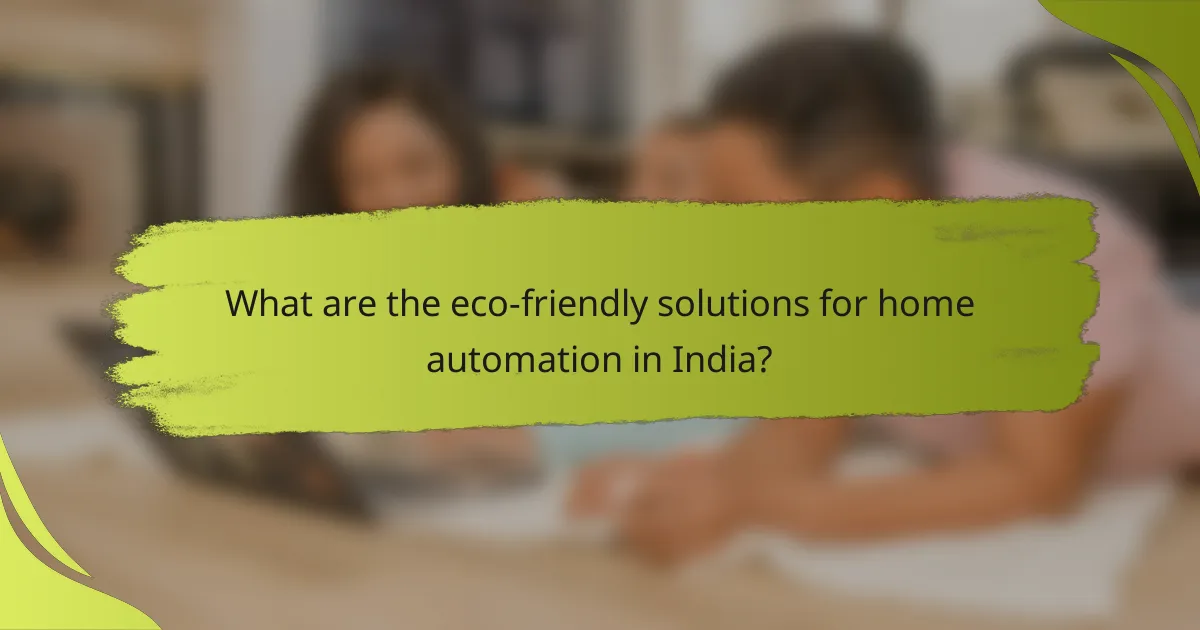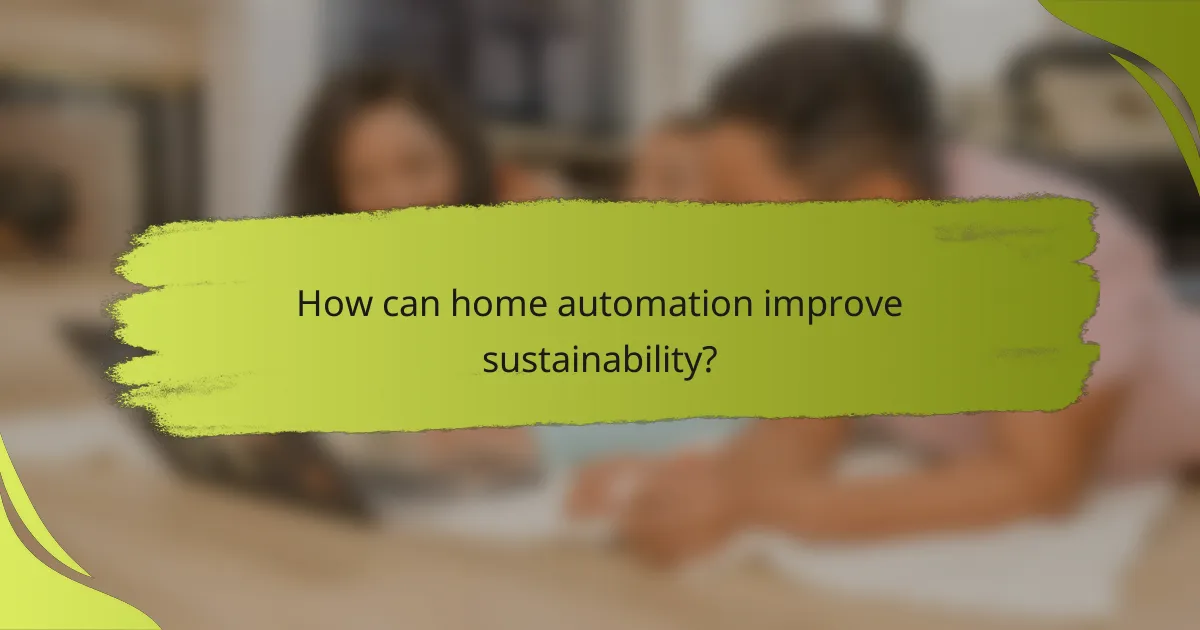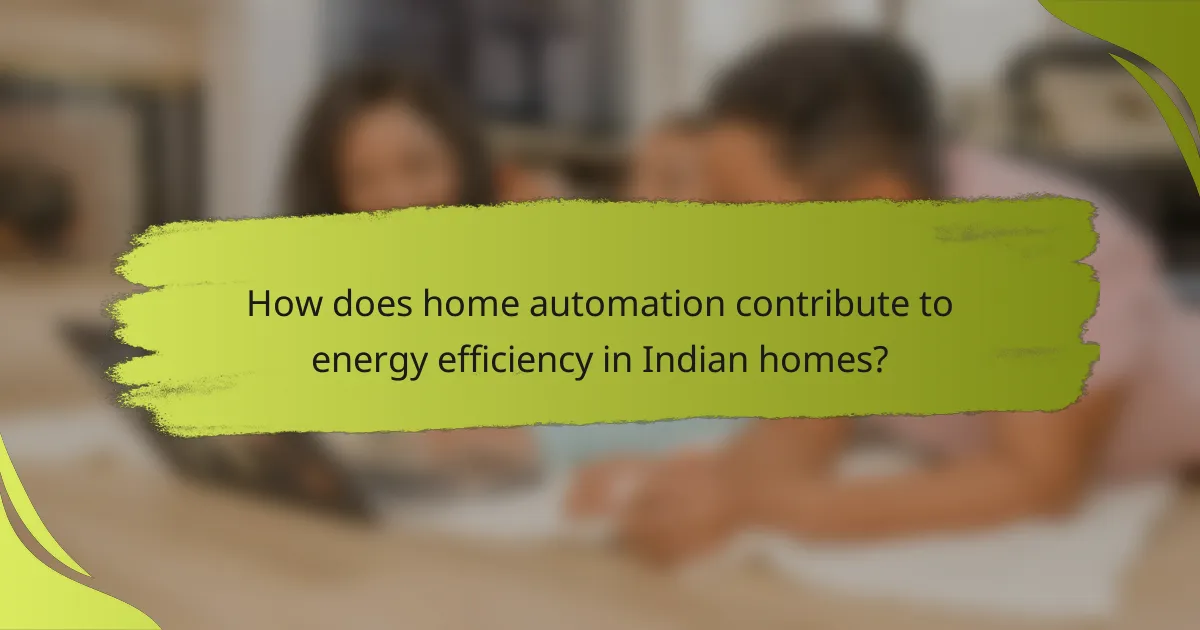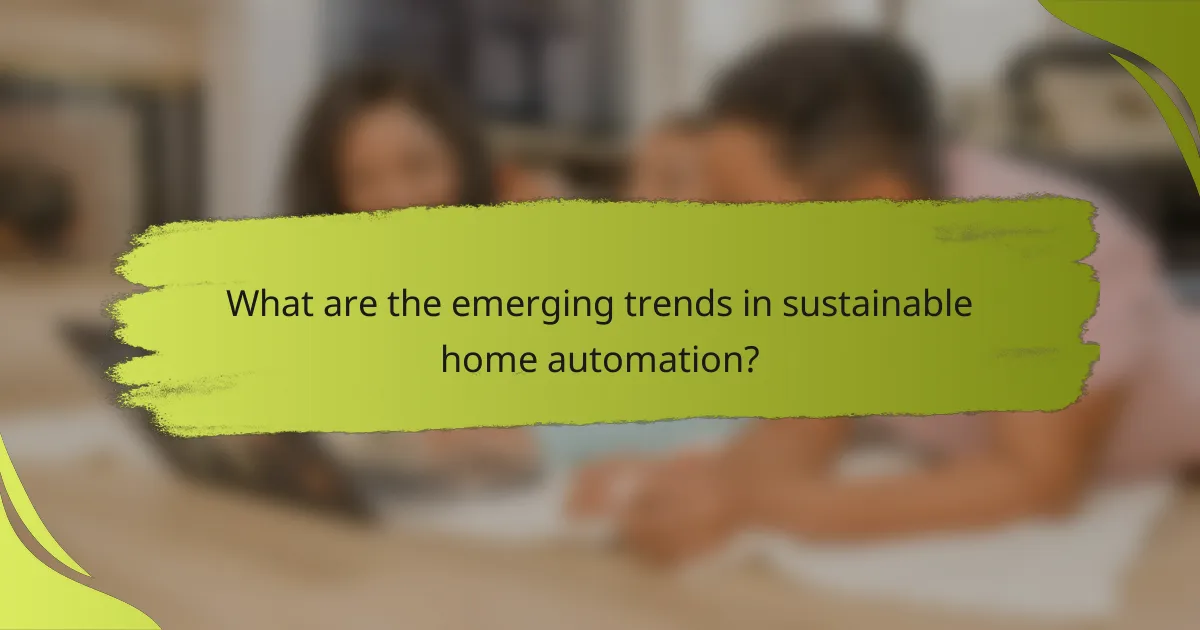Home automation systems are revolutionizing the way we interact with our living spaces, particularly through their focus on sustainability and eco-friendly solutions. By optimizing energy consumption and resource usage, these smart technologies not only enhance convenience but also contribute to a reduced environmental footprint. Implementing such systems can lead to improved energy efficiency, increased comfort, and even higher property value, making eco-conscious living more accessible and effective.

What are the eco-friendly solutions for home automation in India?
Eco-friendly solutions for home automation in India focus on reducing energy consumption and minimizing environmental impact. These technologies not only enhance convenience but also promote sustainability by optimizing resource use.
Smart thermostats
Smart thermostats help regulate home temperature efficiently, reducing energy waste. By learning your schedule and preferences, they can adjust heating and cooling automatically, often resulting in energy savings of around 10-20% on heating and cooling bills.
When selecting a smart thermostat, consider compatibility with your existing HVAC system and whether it can be controlled remotely via a smartphone app. Look for models that offer energy usage reports to track savings over time.
Energy-efficient lighting
Energy-efficient lighting, such as LED bulbs, significantly lowers electricity consumption compared to traditional incandescent bulbs. LEDs use up to 80% less energy and last much longer, making them a cost-effective and eco-friendly choice.
To maximize benefits, replace all high-use light fixtures with LED options and consider installing smart lighting systems that allow for remote control and scheduling. This can further reduce energy use by ensuring lights are only on when needed.
Automated irrigation systems
Automated irrigation systems optimize water usage for gardens and lawns, making them essential for sustainable landscaping. These systems can be programmed to water plants based on weather conditions, ensuring that water is used efficiently and reducing waste.
When implementing an automated system, consider using soil moisture sensors to further enhance efficiency. This ensures that watering occurs only when necessary, which is particularly important in regions with water scarcity.
Solar-powered devices
Solar-powered devices harness renewable energy from the sun, reducing reliance on grid electricity. Options include solar lights, chargers, and even solar panels for home energy generation, which can significantly lower electricity bills.
Investing in solar technology may require an upfront cost, but government incentives and decreasing prices make it increasingly accessible. Evaluate your home’s sun exposure to determine the best solar solutions for your needs.
Smart appliances
Smart appliances, such as refrigerators, washing machines, and ovens, are designed to use energy more efficiently. Many models come with energy-saving modes and can be controlled remotely, allowing users to operate them during off-peak hours when energy rates are lower.
When choosing smart appliances, look for those with high energy efficiency ratings and features that allow for scheduling and monitoring. This not only helps in reducing energy consumption but also contributes to a more sustainable lifestyle.

How can home automation improve sustainability?
Home automation can significantly enhance sustainability by optimizing energy and resource usage, leading to reduced environmental impact. Smart systems enable homeowners to monitor and control their consumption patterns, making eco-friendly choices easier and more efficient.
Energy consumption reduction
Home automation systems can lower energy consumption by automating lighting, heating, and cooling based on occupancy and time of day. For instance, smart thermostats can adjust temperatures when no one is home, potentially reducing heating and cooling costs by 10-20%.
Additionally, integrating energy-efficient appliances with smart technology allows for better management of energy use, such as scheduling washing machines to run during off-peak hours when electricity rates are lower. This not only saves money but also reduces strain on the grid during peak times.
Water conservation
Automated irrigation systems can optimize water usage in gardens and lawns by adjusting schedules based on weather conditions and soil moisture levels. This can lead to water savings of 20-50%, depending on the system’s efficiency and local climate.
Smart home devices can also monitor water usage in real-time, alerting homeowners to leaks or excessive consumption. By addressing these issues promptly, households can significantly reduce their water waste and lower utility bills.
Waste management optimization
Home automation can enhance waste management by providing insights into waste generation patterns. Smart bins equipped with sensors can track waste levels and notify homeowners when it’s time to dispose of trash or recycling, reducing overflow and promoting timely disposal.
Moreover, systems that integrate with local recycling programs can educate users on proper disposal methods, encouraging recycling and composting. This not only minimizes landfill contributions but also fosters a more sustainable community approach to waste management.

What are the benefits of implementing a home automation system?
Implementing a home automation system offers numerous advantages, including improved energy efficiency, increased comfort, and enhanced property value. These systems allow homeowners to control various aspects of their home remotely, leading to significant savings and convenience.
Cost savings on utilities
Home automation systems can lead to substantial cost savings on utilities by optimizing energy consumption. Smart thermostats, for example, can adjust heating and cooling based on occupancy patterns, reducing energy waste by up to 30%.
Additionally, automated lighting systems can turn off lights in unoccupied rooms, further decreasing electricity bills. Homeowners may see monthly savings ranging from $20 to $100, depending on their usage and local utility rates.
Increased property value
Integrating a home automation system can significantly increase property value, appealing to tech-savvy buyers. Homes equipped with smart technology often sell for 5-10% more than comparable homes without such features.
Investing in automation can make a property more attractive in competitive real estate markets, especially in urban areas where convenience and technology are highly valued. Features like smart security systems and energy-efficient appliances can be key selling points.
Enhanced comfort and convenience
Home automation systems provide enhanced comfort and convenience by allowing homeowners to control their environment with ease. Features such as remote access to lighting, heating, and security systems enable users to create personalized settings that suit their lifestyle.
For instance, homeowners can program their systems to adjust the temperature before they arrive home or set the lights to gradually brighten in the morning. This level of control not only improves daily living but also contributes to a more energy-efficient home.

What factors should be considered when choosing a home automation system?
When selecting a home automation system, consider compatibility with existing devices, scalability for future upgrades, and local support availability. These factors ensure that your system meets current needs and adapts to future advancements while providing reliable assistance.
Compatibility with existing devices
Compatibility is crucial when choosing a home automation system, as it determines how well the new system can integrate with your current devices. Look for systems that support a wide range of protocols such as Zigbee, Z-Wave, or Wi-Fi to ensure seamless communication between devices.
Before making a purchase, check the manufacturer’s compatibility list or user reviews to confirm that your existing devices, like smart lights or thermostats, will work with the new system. This can save you from costly replacements and ensure a smoother setup process.
Scalability for future upgrades
Scalability refers to the ability of your home automation system to expand and incorporate new devices over time. A good system should allow you to add new components without requiring a complete overhaul, making it a more cost-effective long-term solution.
Consider systems that offer modular options or cloud-based services, which can easily accommodate future technologies. This flexibility ensures that your home remains up-to-date with the latest innovations in automation without significant additional investments.
Local support and service availability
Local support is essential for troubleshooting and maintenance of your home automation system. Choose a provider that offers accessible customer service, whether through phone, chat, or in-person visits, to ensure quick resolutions to any issues that may arise.
Research local service providers and read reviews to gauge their reliability and responsiveness. Having a support network nearby can greatly enhance your experience and reduce downtime in case of system failures or upgrades.

How does home automation contribute to energy efficiency in Indian homes?
Home automation enhances energy efficiency in Indian homes by optimizing energy consumption through smart technology. By integrating devices that monitor and control energy use, homeowners can significantly reduce waste and lower utility bills.
Real-time energy monitoring
Real-time energy monitoring allows homeowners to track their energy consumption as it happens. Smart meters and energy management systems provide insights into which appliances use the most power, enabling users to make informed decisions about their energy usage.
For instance, using a smart energy monitor can reveal that air conditioning units consume a substantial amount of energy during peak hours. Homeowners can then adjust their usage patterns to avoid high costs, especially during the summer months.
Automated energy management
Automated energy management systems can intelligently control appliances based on real-time data and user preferences. These systems can schedule devices to run during off-peak hours when energy rates are lower, maximizing savings.
For example, smart thermostats can learn a homeowner’s habits and adjust heating or cooling accordingly, ensuring comfort while minimizing energy waste. Additionally, integrating solar panels with home automation can further enhance sustainability by managing energy production and consumption effectively.

What are the emerging trends in sustainable home automation?
Emerging trends in sustainable home automation focus on integrating technology with eco-friendly practices to enhance energy efficiency and reduce environmental impact. These innovations are increasingly important as homeowners seek to lower utility costs while promoting sustainability.
Integration with renewable energy sources
Integrating renewable energy sources, such as solar panels and wind turbines, into home automation systems allows homeowners to harness clean energy. This integration often includes smart inverters and energy management systems that optimize energy use based on availability and demand.
For example, a solar-powered home can automatically adjust energy consumption during peak sunlight hours, storing excess energy for later use. Homeowners should consider local incentives or rebates for renewable energy installations, which can significantly offset initial costs.
AI-driven energy optimization
AI-driven energy optimization utilizes machine learning algorithms to analyze energy consumption patterns and adjust settings for maximum efficiency. These systems can learn from user behavior, making real-time adjustments to heating, cooling, and lighting based on occupancy and preferences.
Homeowners can benefit from AI systems that provide insights into energy usage, helping to identify areas for improvement. Implementing such technology can lead to energy savings of up to 20-30%, making it a worthwhile investment for those looking to enhance sustainability in their homes.
